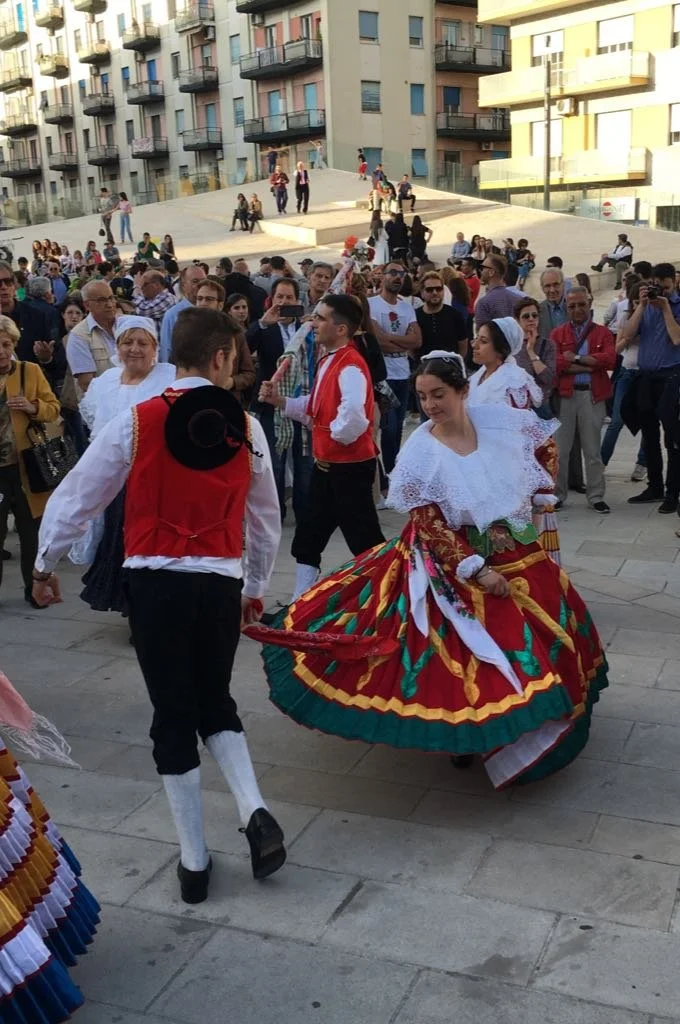From Alamy.com
Tarantella Twist Victoria Proudler ABRSM Grade 3 2025 - 2026
Character/story of the piece – obviously the starting point for the interpretation for this piece is the title. The tarantella is a folk dance from southern Italy danced by couples. Its characteristics include the use of light, fast steps, rapid and swirling gestures, the use of tambourines and in 6/8 time although some are written in 4/4 time. The origin of the tarantella is associated with tarantism which is a complaint that emerged in Italy during the 15C to the 17C in the province of Taranto. Apparently, it was thought that anyone who had been bitten by a tarantula would be cured by frenetic dancing. Wikipedia states ‘the tarantella is a dance in which the dancer and the drum player constantly try to upstage each other by playing faster or dancing longer than the other, subsequently tiring one person out first’. The instruments used in the playing of tarantellas are mandolins, guitars, accordions and of course, tambourines. Sometimes flutes, violins, trumpets and clarinets are used’.
The ABRSM notes for 2025 – 2026 states ‘While the examiner will not expect your student to play a tambourine (!), they will be looking for life and energy in the performance’.
There are videos online that show the energy and vitality of the dance.
The player must spend time considering the movements of the dancers as well as how the instruments are used. The melodic materials create a kind of swirling pattern, with the first phrase, for example, showing the female dancing twirling around with the L.H. in bars 2 and 4 being the tambourine accompanying the dance. The melodic pattern contained in bars 9 – 15 the dancers are weaving around each other. In bars 21 – 31 there is a change of character, with the male dancer taking more of the spotlight. The melodic patterns are particularly evocative.
There are several pieces available for the player to play so they can explore that character of the tarantella. For example, Gounod wrote a piece called The Bagpipers which has a Tarantella character that was in the ABRSM syllabus in 1976, 1992, and 2009- 2010. In the Grade 2 2023- 2024 syllabus there is a Tarantella composed by Agnieszka Lasko.
Main part of the music – as already alluded to, the main part of the music is in the middle section in bar 24 at a fortissimo level. In the final bar the last notes should be played at a forte level. The composer has provided numerous helpful dynamic markings; however, the player should ensure that there are moments where the music is being played at a quieter dynamic level.
Form – this piece is in ternary form with the first section from bars 1 – 16, the middle section from bars 17 – 31 and the final section, essentially a repeat of the melodic material from the first section, is from bars 32 to the end. The music commences in A minor however in bars 5 – 8 the music is in D minor. The key of A minor is reinforced from bars 9 – 16. At the start of the middle section, it commences in A minor, then it moves into D minor before returning to A minor with the emphasis on the dominant chord of A minor. The final section follows the same pattern as the first section.
Phrasing – for most of the time in this piece the phrases are four bars in length and throughout there are sets of two phrases, with the second phrase balancing the first phrase of each set. As a contrast though, the composer has altered the phrasing in the middle section which heightens the main part of the piece. There are three phrases in this section and the balancing aspect is not present. The first two phrases are four bars in length however the third phrase is eight bars in length although this phrase could be considered as being two phrases, each being four bars in length.
Tempo, time signature and rhythmic patterns – clearly the tempo of this music will contribute to the character of the piece. Nevertheless, the player must be able to play this music with complete control and if this is not possible at the suggested speed, another piece for the exam should be considered. The ABRSM notes for 2025- 2026 states ‘the suggested tempo gives the music some drive, but more nimble-fingered students might like to try a faster tempo, as long as control is maintained’. The player must ensure that they regularly check the speed with the metronome as familiarity could result in the piece played too fast.
The listener must be aware that the music is in compound duple time however in bars such as bar 9, there should be no undue accent at the start of the second beat. Throughout this piece the rhythmic impulses change from one in a bar to two in a bar. The rhythmic patterns in this piece should not be difficult for the student to accomplish.
Touch/Articulation – a range of different touches can be employed when playing this piece. In the melodic patterns such as in bar 1 and the R.H. in bar 2 the player should use an energetic, light and slightly intense touch within the overall legato touch. The longer notes such as the dotted crotchets and minims need to be played with degrees of resonance, this being dependent on their context. These notes provide the rhythmic impulses and need to sound for their full value. All the articulation markings must be strictly observed when playing this piece. In my opinion, slightly separating the dotted L.H. crotchets in bars 22 and 23 adds a contrast to how the R.H. is being played in these bars. There should be a definite break at the ends of bar 16, bar 31 and bar 45. The lift at the end of bar 45 provides the listener with a moment to relax prior to the final flourish in the final two bars.
Balance between the hands – overall this is not a consideration when playing this piece. One of the concerns players may have is ensuring that that hands join one another with no perceptible accent. This is especially true when the R.H. is joining the L.H. However, where the L.H plays at the beginning of the bar these notes should be played with a subtle accent. In bars 22 – 31 the balance should be to the R.H. although the L.H. has a significant role to play in this section.
By Rosangela Palmieri - Own work, CC BY-SA 4.0, https://commons.wikimedia.org/w/index.php?curid=116520863
Dynamics – as already discussed the player must ensure that the music is not too loud for long periods. Lowering the dynamics will contribute to the changeable and slightly unpredictable character of the music. The composer has provided numerous crescendo and diminuendo markings. Some variation in the application of these will be appropriate. The highest note of a melodic pattern need not be the loudest in all cases. There is an extremely long crescendo in bars 9 – 16, for example. Some increases and decreases in the dynamic levels in these bars will be appropriate rather than gradually getting louder throughout. And, wherever there are repeats in the melodic material, the crescendos and diminuendos should be played in different ways, so the listener does not lose interest. In bar 29 the p sub must be noticeable. In bars 9 – 16, for example, the R.H. must respond the what the L.H. is doing dynamically. In these bars the L.H. always commences on an E. However, this changes in bars 40 – 45. The last note of a melodic pattern is dynamically important.
Agogic effects – clearly this is not a vital aspect when playing this piece although a few touches of rubato will be beneficial to the playing of this piece. In bars such as bar 16 and bars 28 – 31, the music has slowed down because of the rhythmic patterns used. The composer has written a ritardando in bar 29. A little variation in the application of this will be helpful. The player could slow a little in the second half of bar 27 and then slightly slow in bars 30 and 31 before the a tempo in bar 32. Finally, a slight hesitation before the playing of the final two bars is a stylish addition.
Pedal – there are pedal markings present in bars 24 – 31 and during the final two bars. The player could alter the pedal application in bars 24 – 31 by providing a break in the pedalling in bars 25 and 27 during the second beat, as there is a danger these R.H. notes may blur. The player could also pedal the first beat of bars such as bar 1. The application any pedal when playing this piece should be subtle as a sudden increase in sound will not be appropriate for the character of the piece.
Considerations when playing this piece –
· Bars 24 and 26 could provide a little difficulty because of the R.H. playing one of the notes of the chord the L.H. is playing.
· The music must sound effortless and undemanding.
· The player should notice how in bar 17, instead of the repeating the melodic material from bars 15 and 16, it moves to the other pattern in D minor. This provides the music with a sense of urgency and heightened excitement.
· There is a danger that the player may let go of the dotted minim in bar 46 too soon.
· The use of intervals in the melodic writing is interesting in this piece. The larger intervals provide more drama and suspense to the music such as those used in bar 9.
· Many of the bars consist of chordal patterns. It would be worthwhile mentioning to the player, if they are unaware of it, that, for example, the final two bars consist of an A minor arpeggio pattern.
· Some players may find the learning of the notes in bars such as bar 9 – 15 a little complicated so learning them in groups in each hand would be useful. This is also the case in the R.H. in bars 22 and 23.
· In bar 45, change the fingering in the R.H. to a number 5 and 4 on the final two notes.
· There is a danger that the player will hold the R.H. G V for too long in bars 24 and 26.
· The player could use a degree of flourishes and gestures as this will contribute to the character of the piece.
· Because of the speed of this piece, it would be advisable to practise the piece at a slower speed for most of the time.
· The player should consider what to do with their hands at the hand of the piece so that the final rests are acknowledged.



